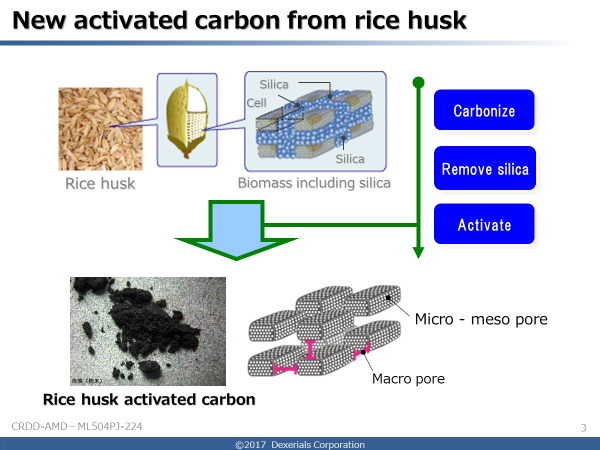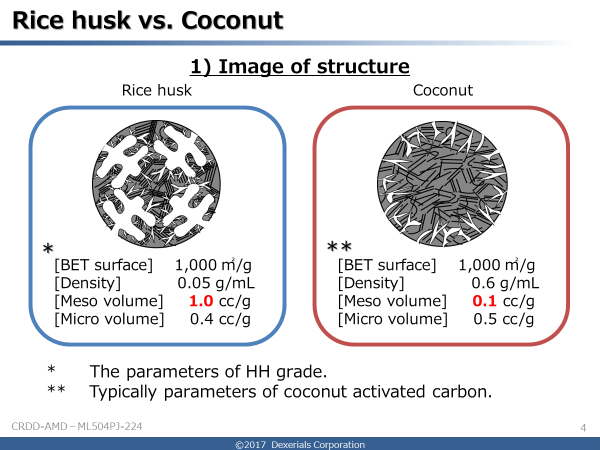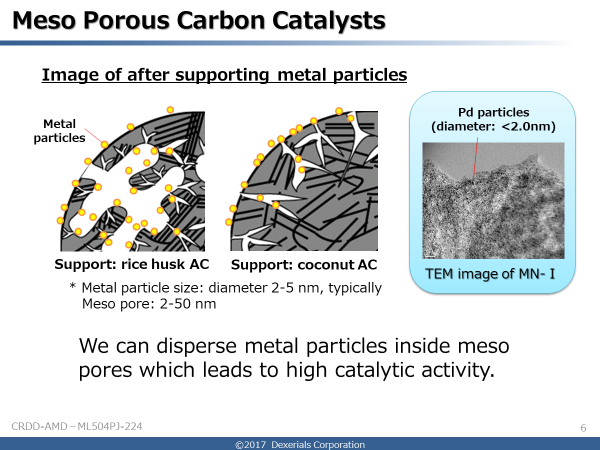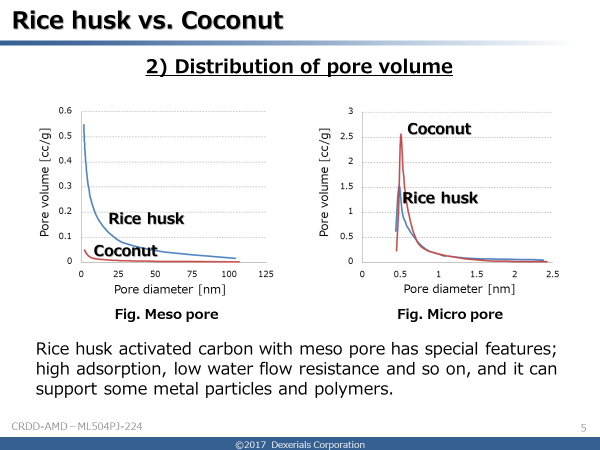Newly developed supported-metal catalysts use highly porous carbon made from rice husks as their supporting substrate. Because the carbon is processed from rice husks, the pore distribution and sizes are different from other substrates and allow this palladium-on-carbon catalyst to offer higher performance than existing catalysts.
Dexerials’ proprietary method of removing silica from rice husks and turning them into activated charcoal creates many more meso pores compared to substrates made from other substances such as coconut shells and resins. The substrate is suitable for a wide variety of metallic catalysts, for example, palladium or platinum. The material offers high dispersibility of metals, offers low air- and water-flow resistance, and provides a large reaction field for catalysis. By using catalysts made with the rice husk substrate, higher catalytic activity and greater selectivity are expected in hydrogenation reactions such as olefin and nitro, and in Suzuki-Miyaura coupling.

During growth, rice husks absorb silica from the soil. By removing the silica from the husks, Dexerials has produced a highly porous carbon material exhibiting a high percentage of meso pores. Dexerials has developed new palladium-on-carbon catalysts using the porous carbon material.

Higher catalytic activity, shorter reaction time, and higher yield can be expected in some organic syntheses. By identifying the catalyst-specific reaction, Dexerials believes that it may be able to develop new synthetic methods. Dexerials looks forward to exploring new and better opportunities for its rice husk palladium catalyst along with potential users.
Technology Benefits Summary
- Dexerials activated carbon from rice husks shows more “meso pores” than do other carbon materials such as activated carbon made from coconut shells. The high number of meso pores leads directly to higher dispersibility of supported metals, and the carbon is suitable as a substrate for catalysts such as palladium and platinum.
- The high number of meso pores offers lower air- and water-resistance and a larger reaction field in case the substrate is used for catalysis. As a result, since the catalyst and the reactant can easily contact each other, you can expect higher catalytic activity, shorter reaction times, and higher product yields.
Technology Benefits (Statement)
Dexerials’ proprietary silica removal method produces activated carbon from rice husks that shows “meso pores.” Such meso pores can measure 2–50nm, in addition to the more usual micro-pores with a diameter <2nm. The meso pore volume is larger than that of conventional activated carbon.

The meso pores are caused by the silica removal. The carbon acts as a substrate for catalysts such as palladium and platinum, and is suitable for a wide variety of other metals used in catalytic reactions. Higher catalytic activity, shorter reaction time, and higher yield can be expected in some organic syntheses.
The material is highly suitable to organic syntheses for the chemical industry and for pharmaceutical production.
In comparison with conventional carbon, the Dexerials material offers
- Higher dispersibility of supported metals (such as palladium)
- Lower air- and water-flow resistance for better contact between the catalyst and the reactant.
- Larger reaction field for catalysis
A tiny amount of silica is left in place by the Dexerials removal method. This silica may add to the effectiveness of the catalyst and substrate combination. Organic synthesis with rice husks shows better yield than do palladium catalysts on other substrates. This may be the result of the leftover trace silica.
Technology Differentiation and Uniqueness
Dexerials’ material is based on carbonized rice husks — a biologically renewable and abundant source material. During growth, rice husks absorb silica from the soil. By removing the silica from the husks, the Dexerials method produces a highly porous carbon material exhibiting many more “meso pores” than conventional carbon. More meso pores make it easier to disperse supported metals. Meso pores can be used as space for chemical reactions. As a result, catalyst reactions can be improved. Rice husks exhibit meso pores that measure 2–50nm, in addition to micro pores (diameters < 2nm). Coconut shells and resins have very few meso pores. In addition, trace silica left in the activated charcoal may help in catalytic reactions.

Because the activated carbon is processed from rice husks, the pore distribution and pore sizes are different from conventional activated carbon, and better suited to catalytic applications.
Because of the difference between Dexerials rice-husk derived carbon substrate and those made from coconut or resin, the Dexerials catalysts are expected to offer higher catalytic activity and special selectivity. The supported metal is highly dispersed, and its particles are smaller than other catalysts.
Development Status Summary:
Porous carbon from rice husks: Some types already are commercially available with mass production.
Palladium catalyst with the porous carbon: Some types are produced in pilot production line. Other types with higher catalytic activity and selectivity are under development.
Dexerials believes that it may be able to develop new synthetic methods, and looks forward to exploring new and better opportunities for its rice husk palladium catalyst along with potential users.
Potential Applications
The porous carbon from rice husks has been developed for catalyst support, but it can be used as adsorbent for refining, decoloration, and so on.
Specific Patent Information
None.
Related Competency
Dexerials Corporation specializes in the manufacturing and sales of electronics parts, adhesive materials and optical materials, manufacturing of magnetic disks, magnetic devices, print media and laminate, etc.
Dexerials owns manufacturing technologies and Sony Corporation owns related patents.
The company name of Sony Chemical & Information Device Corporation has changed to Dexerials Corporation on September 28, 2012.
